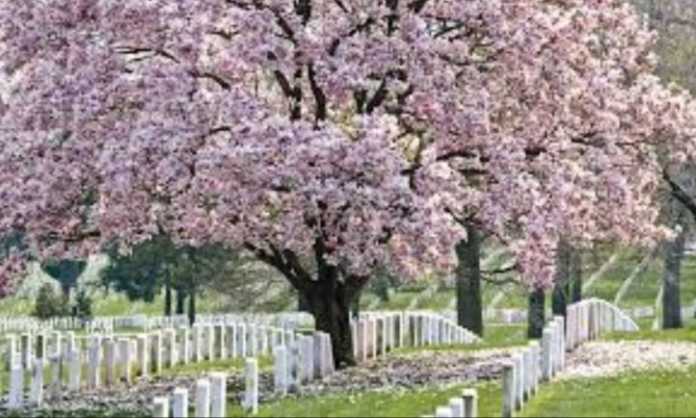
Dwarf weeping cherry tree or Tree or Prunus subhirtellais, is one of the most beautiful trees that exist. You don’t need to have a very big garden to grow this tree because it isn’t the standard cherry tree but the dwarf one. You will still be able to enjoy its beautiful flowers.
Cherry trees have been a symbol of beauty, renewal and spring for centuries. They were first cultivated in Asia over 2,000 years ago, but it was the Japanese who perfected the art of cherry blossom viewing, called Hanami, which involves admiring the beauty of the blossoms in full bloom. Over time, cherry trees were introduced to other parts of the world, including Europe and North America, where they have been popular ever since.
Your garden will be filled with beautiful cherry blossoms what’s better than that.
The dwarf weeping Cherry tree first grew in Japan. Now you can find this tree everywhere in the world. Its blooms are of shades white and pink and it is an ideal tree for your garden. Cherry trees are connected with spring because of their elegance.
What is great about this tree is that it is modifiable to all soil types and temperatures which mean that you will enjoy them all year round.
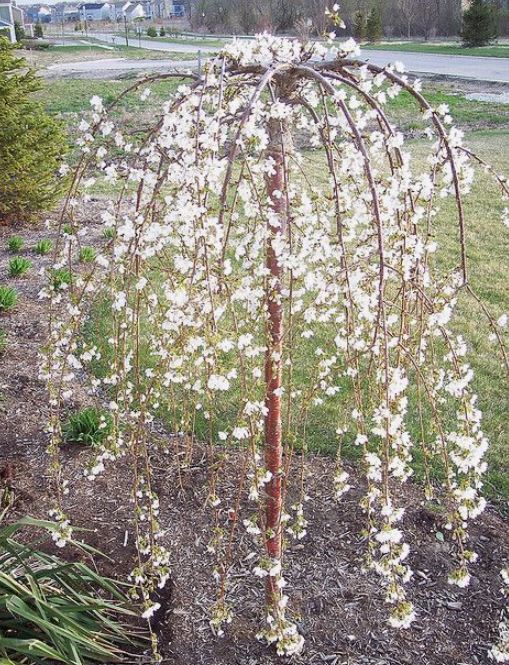
Dwarf Cherry Tree History
The dwarf weeping cherry tree variety was first introduced in the 20th century. Cherry trees first grew in China and Japan. They were introduced to the USA at the end of the 19th century via San Francisco. It is said that thousands of cherry weeping trees were given as gift from Japan to the USA in 1912 and they were planted in Washington D.C.
The tree is widely celebrated in Japanese culture, with its delicate pink and white blooms symbolizing the fleeting nature of life and beauty.
Name Meaning Of Dwarf Cherry Tree
Dwarf Cherry Tree took its name from its branches which drop down and they almost touch the ground. What is magical about this tree is that when it is windy outside the branches follow the wind direction. It is as if a melody is played and the cherry tree is the dancer that follows the music.
The branches grow from the main stem facing outwards and then they arch downwards giving the weeping effect. What is lovely about this tree is that when there is a light breeze the braches might cross with each other and as result, they touch the ground.
Important Environmental Requirements
Once you plant your amazing weeping cherry tree water it immediately but make sure that the water is drained because you don’t want the roots to rot or get the fungus. This type of tree can undergo bacterial blight and other diseases as well that have as a result to shorten its lifespan.
If you want to keep your tree healthy make sure that there is a plethora of air circulation. This specific variety of tree best grows in the US Department of Agriculture plant hardiness zones five through eight and it needs a lot of sun. It is possible that it will grow in warmer climates with limited shade.
Types of Weeping Cherry Trees:
Weeping cherry trees have a variety of types and you can find out those types below:
- Snow Fountains
- Double Weeping Flowering Cherry Tree
- The Hiromi Weeping Tree
- Shidare Yoshino Cherry
- Okame Cherry
- Kwanzan Cherry
There are 6 types of dwarf weeping cherry tree varieties. The standard cherry tree reaches from 20 to 25 feet. The dwarf weeping cherry trees are usually one-half or two-thirds of the original size.
The Snow Fountains Cherry Tree
The snow fountain weeping cherry tree is a dwarf weeping Cherry tree with a height from eight to fifteen feet and spreads from six to eight feet. It is also known as the Prunus subhirtella “Snofozam”. This particular type grows slowly and gives beautiful white flowers.
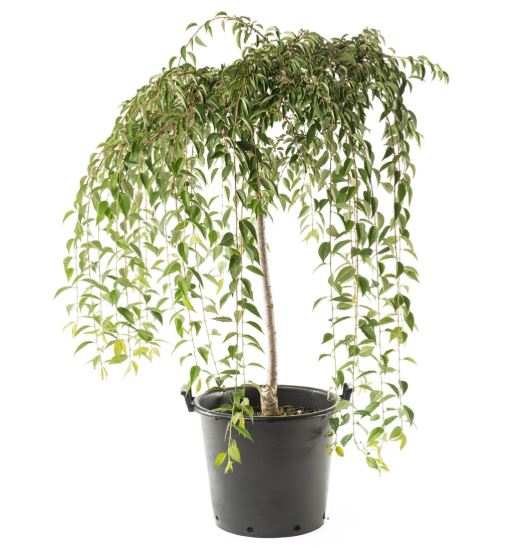
Its branches can touch the ground so pay attention and trim them regularly.
The Double Weeping Flowering Cherry Tree
The Double Weeping Cherry Tree can reach the size of twelve feet. There is a small exception though; some of its varieties might grow up from fifteen to twenty feet. Before you buy the seeds of the specific tree make sure that you ask which variety it is.

This cherry tree is also known by the name of Prunus subhirtella ‘Pendula Flora Plena’.
The Hiromi Weeping Tree
The Hiromi Weeping Cherry Tree is the smallest of the dwarf weeping cherry trees. It is considered to be a special type because it can grow up to seven feet and it spreads from two to four feet which makes it look like a bush. The particular dwarf tree gives magnificent pink blossoms.

Just an unusual and incredible type of cherry tree.
Shidare Yoshino Cherry
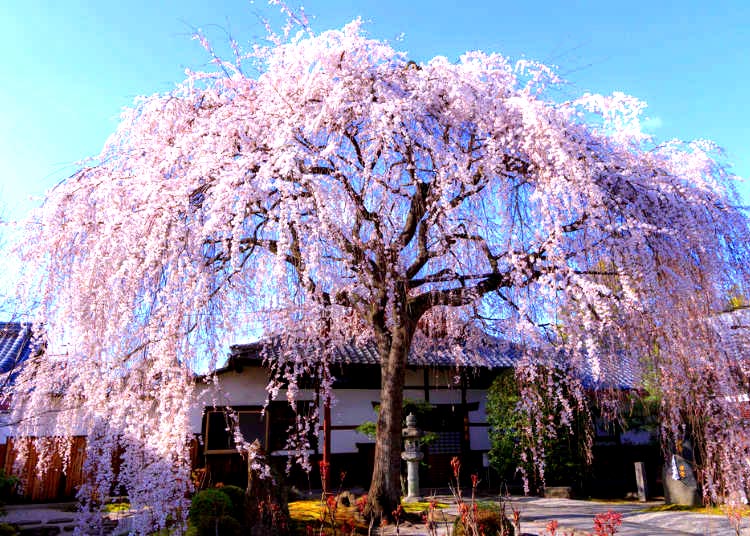
A hybrid tree called the Shidare Yoshino Cherry is well-known for its abundance of pink or white blooms that bloom in the first few weeks of spring. This tree, which matures to a height of 10 to 15 feet, is a favorite for parks and expansive landscapes.
Okame Cherry

A deciduous tree called the Okame Cherry is well-known for its abundant early-spring blooms of rosy-pink flowers. This tree, which matures at a height of 20 to 25 feet, is favored for parks and expansive landscapes.
Kwanzan Cherry
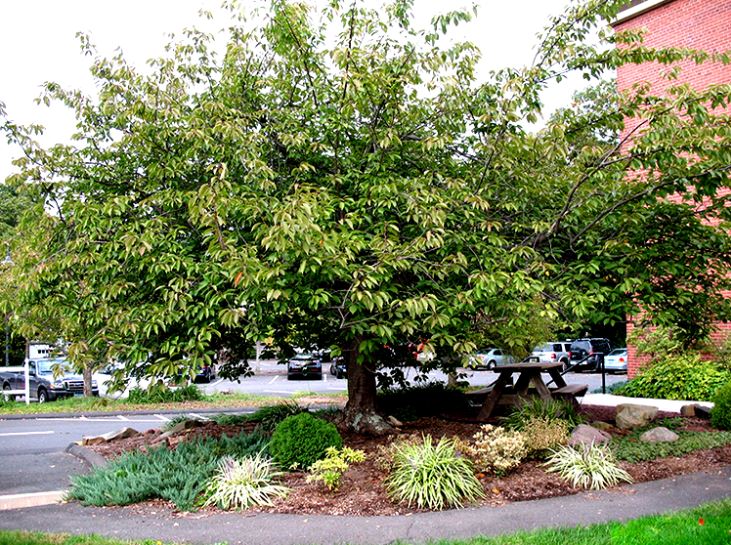
The Kwanzan Cherry is a deciduous tree that blooms in the first few weeks of spring with enormous, double pink blossoms. This tree, which matures at a height of 20 to 25 feet, is favored for parks and expansive landscapes.
These are but a handful of the several varieties of weeping cherry trees that exist. When selecting a tree, take into account your unique requirements and tastes as well as the local environment and growth circumstances.
Diseases and Pests
Like all plants, dwarf weeping cherry trees are susceptible to diseases and pests. The most common diseases include powdery mildew and verticillium wilt. To prevent these diseases from affecting your tree, it’s important to plant in well-drained soil and to keep the tree healthy by providing it with proper care and nutrition.
As for pests, the most common ones include aphids, scale insects, and caterpillars. If you notice any pests on your tree, it’s important to treat them immediately to prevent them from causing serious damage.
Selection of Dwarf Cherry Trees
You should be careful when you will go to buy the seed of the dwarf weeping cherry tree because most of the varieties are full sized ones. That means that you should visit a proper nursery center that will give you information before you buy it.
Where and When to Plant the Dwarf Weeping Cherry Tree
As a gardener Expert, I know that choosing the right location for this plants is essential for their success. The Dwarf Weeping Cherry Tree is no exception. Here are some important factors to consider when deciding where and when to plant your tree:
Climate
The Dwarf Weeping Cherry Tree is hardy in USDA zones 5-8, which means it can grow in a range of climates from cold to temperate. However, it prefers cool, moist climates, and is not well-suited to hot, dry regions. When choosing a location, make sure to consider the local climate and temperature patterns, as well as the average rainfall in your area.
Sunlight
The Dwarf Weeping Cherry Tree requires plenty of sunlight to grow and bloom properly. Ideally, it should be planted in a location that gets at least 6 hours of direct sunlight per day. If you live in a region with hot summers, you may want to choose a location that provides some shade during the hottest part of the day.
Soil
The Dwarf Weeping Cherry Tree is not particularly fussy about soil, but it does prefer well-draining soil that is moist and fertile. If your soil is heavy or clay-like, consider adding compost or other organic matter to improve its structure and fertility. You should also make sure to avoid planting your tree in a location where water accumulates, as this can lead to root rot.
Timing
The best time to plant the Dwarf Weeping Cherry Tree is in the fall or early spring, before the growing season begins. This allows the tree to establish its roots and get a good start before the warm weather arrives. If you plant your tree in the summer or late spring, make sure to provide plenty of water to help it get established.
Space
Finally, consider the size of your Dwarf Weeping Cherry Tree when choosing a location. Most varieties will reach a mature height of 6-10 feet, with a similar spread. Make sure to plant your tree in a location that provides enough space for it to grow and spread its branches without being cramped or crowded.
By taking these factors into account, you can choose the perfect location for your Dwarf Weeping Cherry Tree, and enjoy its beauty for years to come.
Planting a Dwarf Weeping Cherry Tree
Another important thing is that you need to know when to plant a Weeping Cherry Tree. We have the answer to this important question.The time has come for you to plant your unique dwarf weeping cherry. You should provide the soil with the appropriate care as you would for any kind of tree that you were going to plant.
The next step would be to dig a hole that will have the double size of the root ball.
Then remove the young tree form the initial pot and place it into the hole. Once you have finish with that, cover the hole with soil and press carefully around the stem area. Last but not least, if you plan to plant more than one dwarf weeping cherry trees make sure that you will leave twenty feet between them.
Taking Care of your Dwarf Weeping Cherry Tree
If you want to learn how to take care this beautiful tree, you must read this: Taking care of your dwarf cherry tree is the most important thing. Once you plant the tree you must immediately water it and mulch it. If you do that you will maintain the moisture of the soil and the annoying weeds will be controlled.
All of the above will have as a result to have a better surface for the tree and for the weeping branches that most probably will touch the ground. Don’t forget to water your young tree and especially during the cold and dry months because you want to have a lot of marvelous flowers.
Time for some Pruning
If you want to have a healthy dwarf weeping you should prune it as often as you can. When the tree is in a dormant state and that happens during autumn you should prune it. Clear the lower branches and the weak sprouts. Pay attention and make sure that all tips have different lengths and that they are all above the ground.
When the spring will come you will see the first flowers buds that will fall from the twigs.
When you prune your tree you will keep it free from bacteria and other tree diseases. If you want the branches to look downwards remove the ones that point upwards. You will shape your cherry tree the way you want it.
Without realizing it your dwarf weeping cherry tree will give you beautiful blossoms that you will be able to enjoy while you are sitting in your garden. If you want your tree to be healthy don’t forget to prune it and water it.
You can plant it in your garden or keep it in a pot. Either way, it will give you beautiful blossoms that during the springtime will attract all your friends and neighbors. Prepare your garden properly, follow our tips and you will have an amazing result that you will be proud of.
If you have a big garden plant more than one and you will see how amazingly they will move once there is a light breeze. Beauty is everywhere around us and this tree is dazzling.
FAQs About Dwarf Weeping Cherry Trees
If you’re considering planting a Dwarf Weeping Cherry Tree in your garden, you may have some questions about their care and maintenance. Here are answers to some of the most frequently asked questions:
How tall do dwarf weeping cherry trees get?
Smaller than other varieties of cherry trees, dwarf weeping cherry trees typically mature at a height of 6 to 10 feet. When compared to other cherry trees, some varieties of cherry trees may grow a little bit taller, but they are still rather little.
Can you keep a weeping cherry small?
Yes, by giving it regular trimming, you may keep a weeping cherry tree small. Regular trimming can keep the tree from becoming too big for your landscape by helping to control its size, shape, and overall form. Pruning will, however, also decrease the quantity of blossoms the tree produces, so it is a trade-off.
Are dwarf weeping cherry trees messy?
A modest number of petals and leaves can fall from dwarf weeping cherry trees, although they are not as untidy as other cherry tree varieties. You may decrease the amount of cleanup necessary by keeping your tree looking tidy and neat with routine maintenance.
What is the best small weeping cherry tree?
The ideal tiny weeping cherry tree for you will depend on your individual requirements and tastes, thus there is no one “best” option. The Snow Fountains Weeping Cherry, the Shidare Yoshino Cherry, and the Okame Cherry are a some of the most well-known kinds. Make sure to properly explore different types so you can pick the one that is best for you because each one has distinctive qualities and traits of its own.
Conclusion
The dwarf weeping cherry tree, in conclusion, is a lovely and sophisticated addition to any landscape. This tiny tree is likely to stand out in your outdoor area with its lovely pink or white blossoms and pendulous branches.
It’s vital to bear in mind the dwarf weeping cherry tree’s requirements for well-drained soil, full light, and routine watering while planting, caring for, and maintaining the tree. Your miniature weeping cherry tree is likely to flourish and provide you years of pleasure if you give it the right care and attention.



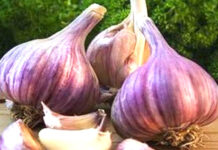



![Rose Names And All Rose Types – The Most Detailed Guide [2022] rose names](https://www.yardious.com/wp-content/uploads/2018/05/rose-names-100x70.jpg)











